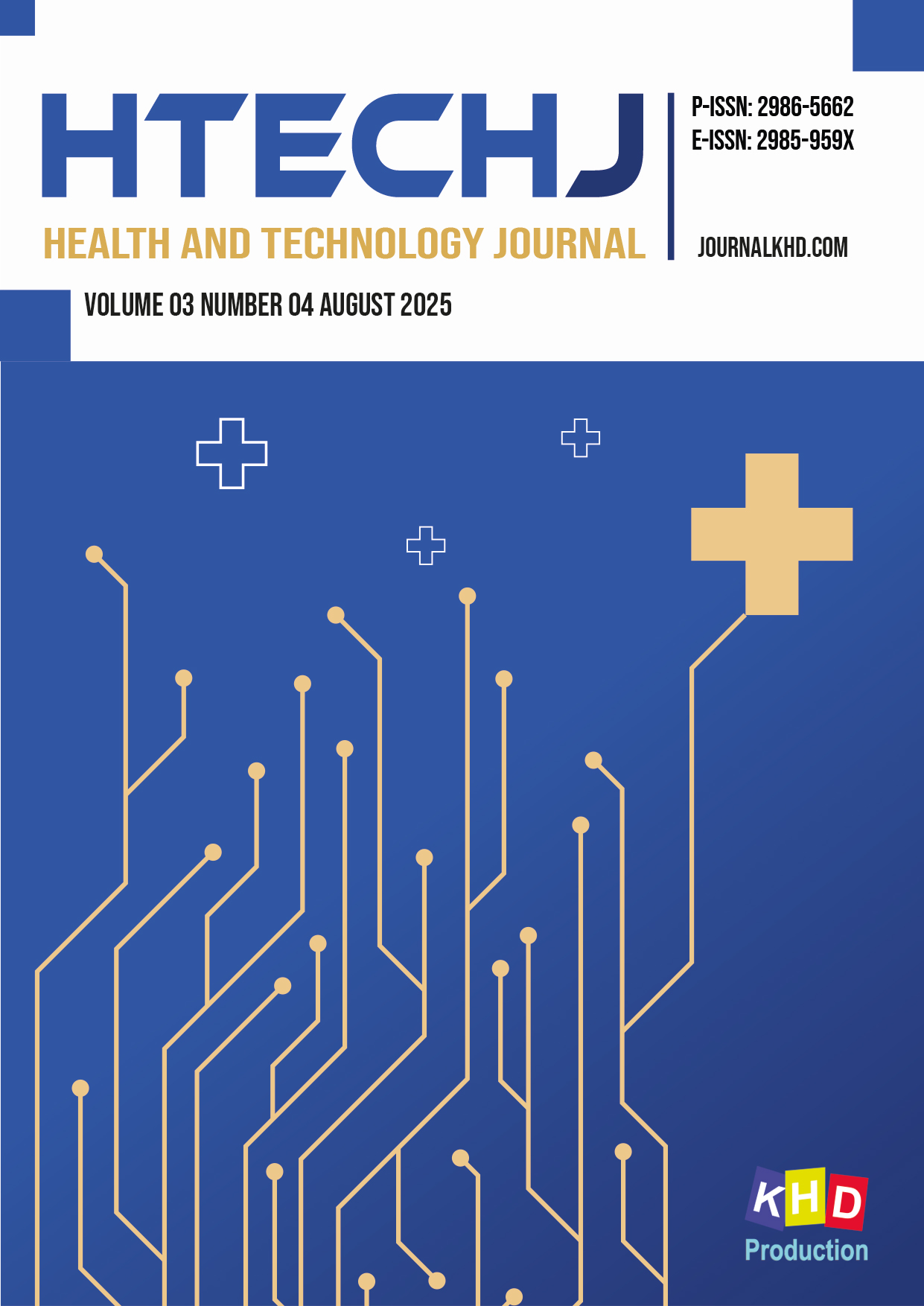Midwifery Care for Pregnant Women with Late-Term Pregnancy
DOI:
https://doi.org/10.53713/htechj.v3i4.362Keywords:
lateterm, postterm, postdate, section caesareaAbstract
Late-term pregnancy occurs at 41 weeks to 41 weeks and six days of gestation. It poses potential risks to both the mother and the fetus. Appropriate management is crucial for preventing morbidity and mortality. This study aims to analyze Midwifery Care for Pregnant Women with Late-Term Pregnancy. This study employs a case study design with a comprehensive midwifery care approach for one patient. Data collection was carried out using a combination of interviews, direct observation, physical examinations, and document review. The analysis followed the structured stages of the midwifery care process, which include assessment, diagnosis, implementation, and evaluation. The case study was conducted on Mrs. YS, who did not experience signs of labor and refused induction. The diagnosis was established as G3P1011 with a gestational age of 42-42 weeks and a late-term intrauterine live fetus. The intervention involved referring the patient to the hospital for a cesarean section. The evaluation showed that the C-section went well, and the mother and baby were in good health after delivery. This case study highlights the importance of early detection and appropriate decision-making when managing overdue pregnancies. Refusing induction poses a clinical challenge requiring an educational and collaborative approach to avoid increasing the risk of maternal and neonatal complications.
References
Abidin, Rizka Yunita, & Sharifah Aini Tika Rachmad. (2022). The Relationship Between Anxiety Levels and Pain Degrees in Postoperative Caesarean Patients at Pasirian Hospital. Nursing and Health Sciences Journal (NHSJ), 2(2), 159-66. https://doi.org/10.53713/nhs.v2i2.125
Al-Genedy, Ali & Entesar Mohammed Qushash. (2023). POSTTERM PREGNANCY: MATERNAL AND FETAL OUTCOMES. Electronic Journal of University of Aden for Basic and Applied Sciences EJUA-BA, 4(4). https://doi.org/10.47372/ejua-ba.2023.4.307
Bayraktar, B., Vural, T., Gölbaşı, C. (2022). Fetal gender distribution in post-term pregnancy and intrauterine death: Maternal and neonatal outcomes by fetal sex. Gulhane Medical Journal, 64(1), 73-78. http://dx.doi.org/10.4274/gulhane.galenos.2021.91300
Bhide, Amarnath. (2021). Induction of labor and cesarean section. Acta Obstetricia et Gynecologica Scandinavica. https://doi.org/10.1111/aogs.14068
Blecher, Y., Michaan, N., Baransi, S., Baruch, Y., & Yogev, Y. (2020). Against medical advice for induction of labor due to post-term pregnancies – the impact on pregnancy outcome. The Journal of Maternal-Fetal & Neonatal Medicine, 35(20), 3979–3983. https://doi.org/10.1080/14767058.2020.1845645
Das, P. K., Mukherjee, J., & Banerjee, D. (2023). Fertilisation, gestation and parturition. In Textbook of Veterinary Physiology (pp. 569-613). Springer Nature Singapore. https://doi.org/10.1007/978-981-19-9410-4_23
Kammies, J. D., De Waard, L., Muller, C. J. B., & Hall, D. R. (2022). Delivery outcomes in women with morbid obesity, where induction of labour was planned to prevent post-term complications. Journal of Obstetrics and Gynaecology, 42(8), 3450–3455. https://doi.org/10.1080/01443615.2022.2128730
Latif, Sara & Catherine Aiken. (2024). Prolonged pregnancy: balancing risks and interventions for post-term gestations. Obstetrics, Gynaecology & Reproductive Medicine, 34(5), 127-133. https://doi.org/10.1016/j.ogrm.2024.02.004
Mitaol, Modesta,. Winfrida C. Mwita, Cecilia Antony, Hamidu Adinan, Benjamin Shayo, Caroline Amour, Innocent B. Mboya I., Michael Johnson Mahande. (2023). Recurrence of post-term pregnancy and associated factors among women who delivered at Kilimanjaro Christian Medical Centre in northern Tanzania: A retrospective cohort study. PLOS ONE, 18(4), e0282078. https://doi.org/10.1371/journal.pone.0282078
Nu, U. T., Pervin, J., Rahman, M., Kamal, K. T. B., Aktar, S., Huda, F. A., Ganguly, S., El Arifeen, S., Persson, L. Å., & Rahman, A. (2024). A cohort study of the occurrence of post-term births and its association with perinatal mortality in a rural area in Bangladesh. Journal of Global Health, 14, 04238. https://doi.org/10.7189/jogh.14.04238
Pallavee, P., & Vishalakshi L, A. (2023). Prolonged Pregnancy. In Labour and Delivery: An Updated Guide (pp. 373-385). Springer Nature Singapore. https://doi.org/10.1007/978-981-19-6145-8_27
Parasiliti, M., Vidiri, A., Perelli, F., Scambia, G., Lanzone, A., & Cavaliere, A. F. (2023). Cesarean section rate: navigating the gap between WHO-recommended range and current obstetrical challenges. The Journal of Maternal-Fetal & Neonatal Medicine, 36(2). https://doi.org/10.1080/14767058.2023.2284112
Ramonienė, G., Malakauskienė, L., Savukynė, E., Maleckienė, L., & Gruzdaitė, G. (2024). Pregnancy Complications and Outcomes in Obese Women with Gestational Diabetes. Medicina, 61(1), 51. https://doi.org/10.3390/medicina61010051
Ranjbar, A., Mehrnoush, V., Darsareh, F., Pariafsay, F., Shirzadfardjahromi, M., & Shekari, M. (2023). The Incidence and Outcomes of Late-Term Pregnancy. Cureus, 15(1), e33550. https://doi.org/10.7759/cureus.33550
Saurabh S. (2023). A study to assess the maternal and perinatal outcome of postdated pregnancy at a tertiary care institution of Eastern India. Int J Reprod Contracept Obstet Gynecol, 12, 3469-3473. DOI: https://doi.org/10.18203/2320-1770.ijrcog20233546
Simões, J., & Stilwell, G. (2021). Caesarean Section. In Calving Management and Newborn Calf Care: An interactive Textbook for Cattle Medicine and Obstetrics (pp. 181-208). Springer International Publishing. https://doi.org/10.1007/978-3-030-68168-5_8
Singh, N., Misra, D., & Srivastava, S. (2020). Kehamilan lewat waktu: dampaknya terhadap ibu dan janin. Jurnal Internasional Reproduksi, Kontrasepsi, Obstetri dan Ginekologi, 9(8), 3223–3227. https://doi.org/10.18203/2320-1770.ijrcog20203299
Sulistiorini, Shinta Novelia, & Siti Syamsiah. (2022). Post Caesarean Section Wound Healing Among Postpartum Women Who Consumed Boiled Eggs. Nursing and Health Sciences Journal (NHSJ), 2(2), 154-58. https://doi.org/10.53713/nhs.v2i2.74
Teal, E. N., Lewkowitz, A. K., Koser, S. L. P., Tran, C. B. N., & Gaw, S. L. (2021). Quantifying the Risks and Benefits of Continuing Labor Induction: Data for Shared Decision-Making. American journal of perinatology, 38(9), 935–943. https://doi.org/10.1055/s-0039-1701025
Tegene, D., Mohammed, K., & Amana, K. (2022). The prevalence of post-term pregnancy and its associated factors at Adama Hospital Medical College, Adama, Ethiopia. Ethiopian Journal of Reproductive Health, 14(01), 9. https://doi.org/10.69614/ejrh.v14i01.545








